
* In the 1970s, the Soviet Antonov organization began work on a twin-fan military cargolifter to feature excellent short-field capabilities, with the aircraft emerging in the 1980s as the "An-72". It was soon followed by a civil variant, the "An-74". The series was built in relatively modest numbers, but remains in service and work has been performed on follow-ons. This document provides a history and description of the An-72 / An-74. A list of illustration credits is given at the end.
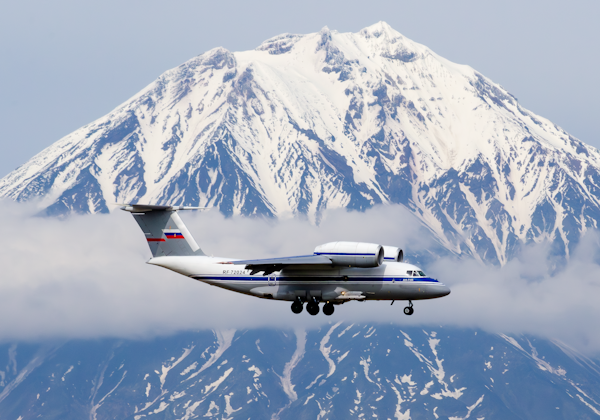
* In 1972, the experimental design bureau (OKB in its Russian acronym) established by Oleg K. Antonov and based in Kyiv in Ukraine began work on a twin-turbofan aircraft to replace the organization's An-26 twin-turboprop cargolifter. The new design, which was assigned the OKB code designation of "Aircraft 200", was to be a medium-lift aircraft with good rough field / short take-off & landing (STOL) operational capability.
The initial design effort was conducted on funds left over from the yearly budget, which would not have sustained work on the project, but the VVS (Voyenno Vozdushniye Sily / Red Air Force) liked the concept and backed it. The result was a requirement issued by the VVS and MAP (Ministry of Aircraft Production, more or less), leading in 1973 to the formal initiation of development for the "An-72", as the Aircraft 200 was officially designated.
Three ground-test airframes were built, followed by the first flight prototype, which performed its initial flight out of Kyiv, Ukraine, on 22 December 1977, with test pilot V.I. Terskikh at the controls, backed up by flight engineer A.L. Kroots. Early tests showed the aircraft was "a pleasure to fly", featuring modern flight instrumentation, and low noise levels; its STOL performance was outstanding. The third ground-test article was brought up to flight standard to help with air trials. Various problems were uncovered and fixed, with the first prototype attending the Paris Air Show in May 1979, the machine being painted in tidy Aeroflot (Soviet state airline) colors and putting on an impressively agile flight display. NATO assigned the type the reporting name of "Coaler" -- later "Coaler-A" when other variants appeared.
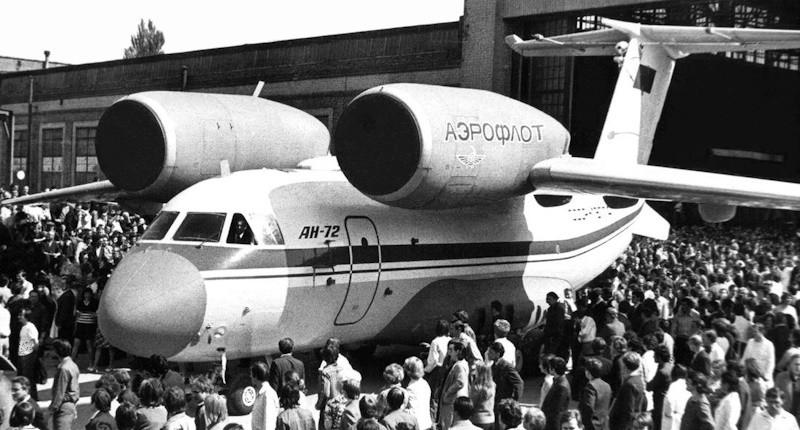
By the time of the An-72's appearance at the Paris Air Show, preparations were already under way for series production, with a state factory in Kharkiv selected to do the job. However, production plans ran into a big snag. Aeroflot was very interested in the An-72; although the aircraft had been designed to military specs as a tactical cargolifter and looked it, there were a lot of short and rude civil airfields in the Soviet north and Far East, and a STOL airliner / freightliner would be very handy. The problem was that Aeroflot had more aggressive requirements: while the military only wanted a 5-tonne (5.5-ton) maximum payload, Aeroflot wanted a 10-tonne (11-ton) maximum payload, plus about 50% more range with normal payload, and more cargo hold volume.
Although the prototype An-72 machines could actually handle a maximum payload of 7.5 tonnes (8.25 tons) in overload condition, of course that still wasn't enough to meet the Aeroflot spec. To handle the new requirements, the wing area was increased, by the simple measure of chopping off the outer wings at about mid-span and putting larger outer wings in their place, resulting in a "kink" at midwing, and shallower leading-edge sweep for the outer span. The original idea had been to replace the wings from the wing roots outward, but lack of machinery that could handle the long wing skinnings torpedoed that idea.
Additional fuel tanks were installed in the wing center section to get the specified range. To increase cargo volume, a fuselage plug 1.4 meters (4 feet 7 inches) long was inserted forward of the wing; it apparently improved the aircraft's handling characteristics. The second flight prototype was modified to the new configuration; a third flight prototype may have been built from the "ground up" in the new configuration, but sources are unclear on the matter.
Bringing the aircraft into production turned out to be another headache. Part of the difficulty was purely bureaucratic -- the Kharkiv plant had been working on Tupolev aircraft, and Antonov's ways of doing things were different, while the An-72 design team had been pulled off to work on another project, meaning documentation was inadequate, and getting help from the design team was problematic. There was also the fact that the An-72 used new and relatively unfamiliar technologies, for example extensive composite assemblies, and getting up to speed in manufacturing such kit was not always straightforward. The initial production An-72 didn't fly until December 1985, three years behind schedule. First deliveries of the An-72 to the VVS began in 1986.
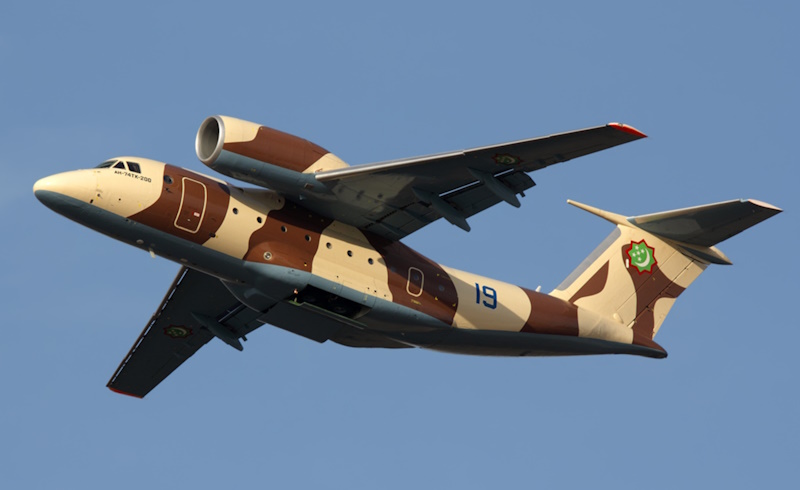
* In the meantime, the Antonov OKB was working on the civil version. What Aeroflot wanted at the outset was a transport for Arctic operations to replace the antiquated twin-piston-engine Il-14 in this role. Formal go-ahead on the development of the "An-72A" -- where the "A" effectively stood for "Arctic" -- was granted in 1983. One of the initial An-72 prototypes was modified as the An-72A prototype, performing its first flight on 29 September 1983, with Sergey A. Gorbik and V.A. Shlyakov as aircrew. By that time, the civil variant had been redesignated "An-74". Evaluation was protracted, with pre-production machines not flying until 1986, and the type not going into service until 1988.
Somewhat confusingly, NATO labeled the military An-72 the "Coaler-C" and the civil An-74 the "Coaler-B", simply because the An-74 had been observed first. Some sources also linked the An-72A to the An-72 instead of the An-74. Westerners always had difficulty sorting through the habitual Soviet cloak of secrecy.
BACK_TO_TOP* The military An-72 cargolifter featured a high-mounted swept wings with an Ivchenko (later Progress) D-36 Series 2A high-bypass turbofan mounted on top of each wing; a tee tail; a rear loading ramp; and tricycle landing gear. The An-72 had a considerable resemblance to the contemporary US Boeing YC-14 experimental cargolifter; Antonov engineers denied any connection, but even Russian sources admit that early models of what would become the An-72 were strikingly similar to the YC-14, and the initial An-72 prototypes still retained a clear likeness. That said, the two aircraft only shared an overall configuration, with some elements that would have been included in any jet cargolifter, and they had no real similarity at the detail design level.
The An-72's wings had 17 degrees of leading-edge sweep inboard, and 10 degrees of sweep outboard; the wings had an anhedral droop of 10 degrees on the sections outboard of the engines. The wings featured an elaborate set of high-lift devices to help with STOL performance: triple slotted flaps inboard, double slotted flaps at midwing, and a leading-edge slat in three sections on each wing. There were two-section ailerons at each wingtip, along with four spoilers as well, with the inner two spoilers used as "lift dumpers", and the outer two for roll control in conjunction with the ailerons.
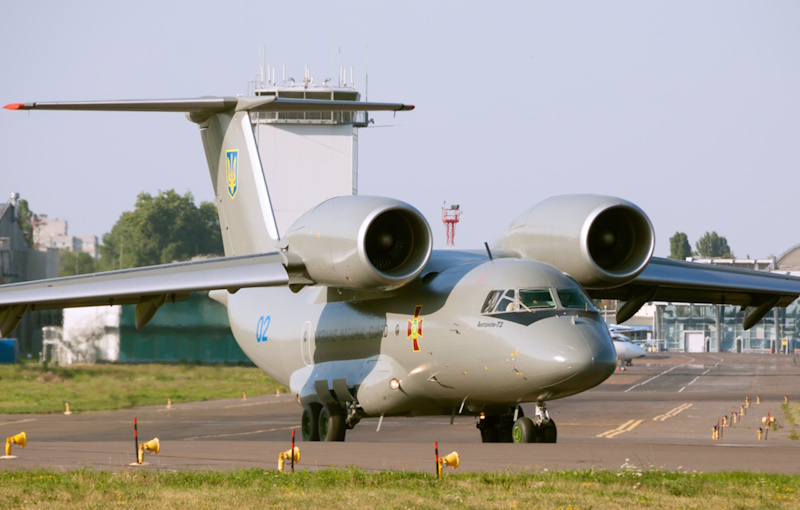
The tee tail assembly featured a tailfin with a leading-edge sweep of 33.5 degrees and a two-segment rudder in the rear, the top segment having a sharper sweep than the lower -- the bottom had the same sharp sweep in very early prototype configuration. The tailplane had a leading-edge sweep of 23 degrees; it was variable incidence to support flight trimming, but with elevators in the rear, and an "inverted slat" under the forward leading edge to improve handling during take-offs and landings. There was a spindle-shaped fairing covering the junction of the tailfin and tailplanes. All flight controls were hydraulically actuated, driven by a dual hydraulic system. All flight surfaces were de-iced using engine bleed air.
Each main landing gear assembly consisted of two wheels in tandem, retracting inward into fairings along the sides of the fuselage. The nose gear featured twin wheels, retracted forward, and was steerable. Landing gear units were hydraulically actuated, opening automatically if there was a hydraulics system failure.
Each D-36 Series 2A turbofan provided 63.74 kN (6,500 kgp / 14,330 lbf) thrust; the top-mounted engine installation directed airflow over the wing and flaps to provide additional lift, and also gave protection against foreign-object ingestion on rough fields. The engine cowlings featured a leading-edge de-icing system, also driven by engine bleed air; and the engines were fitted with bucket-type thrust reversers to reduce landing roll. There were seven fuel tanks, all in the wing center section, with single-point refueling and a total capacity of 16,250 liters (4,288 US gallons).
There was an auxiliary power unit (APU) in the rear of the right main gear fairing for ground power and engine starting. In the prototypes and early production, it was a TA-8V APU, with production then settling on the TA-12 APU. Each engine nacelle and the APU bay included a fire-extinguisher system. Engine / APU bleed air drove air conditioning systems, with the cargo bay air conditioner capable of acting as a refrigerating unit for perishable cargoes.
There were three crew, including pilot, copilot, and navigator in a pressurized forward cabin. Photos show the control panels painted turquoise, the Soviets finding such "pleasing to the eye" coloration to be less tiring on long flights. The crew got in and out of the aircraft through a door with a porthole on the forward left side of the aircraft, the door hinging open towards the front; a boarding ladder was stowed separately, to be pulled out and put in place. The door could be opened in flight to provide a windscreen for bailing out. Standard avionics included radios, radio navigation systems, flight data recorder, and identification friend or foe (IFF) transponder; along with an automatic flight control system / autopilot, Gradiyent navigation-weather radar in the nose, and a Doppler ground-tracking radar under the belly. The windshield was electrically de-iced, and featured wipers.
The pressurized cargo hold had dimensions of 10.5 x 2.15 x 2.2 meters (34 feet 5 inches x 7 feet 1 inch x 7 feet 3 inches). The tail ramp hinged down to the ground via twin hydraulic rams for normal ground loading, with two or four ramps attached for driving vehicles into or out of the aircraft; for loading directly from a truck bed or for paradropping, the ramp could be pulled into the rear fuselage. Hydraulic jacks could be extended from the rear of each landing gear fairing to prevent the aircraft from tipping back when being loaded.
The An-72 could carry 57 paratroops on tip-up seats along the walls; additional seats could be installed in the center of the cargo bay for a total of 68 passengers. In the casualty evacuation ("casevac") role, the An-72 could carry 24 litters and 12 seated casualties, along with a medical attendant; operating as a freight hauler, it could carry 10,000 kilograms (22,000 pounds) of cargo. There was a traveling overhead electric hoist with a maximum load capacity of 2,500 kilograms (5,510 pounds). The floor of the cargo bay featured a network of threaded holes for attaching cargo tie-downs; a roller conveyor system could be installed on the floor to ease handling and paradropping of cargoes. The floor was marked to help a loadmaster properly position loads. There was a porthole fore and aft on each side of the cargo bay, with the rear window on the right embedded in the emergency exit.
___________________________________________________________________
ANTONOV AN-72 "COALER-C":
___________________________________________________________________
wingspan:
31.89 meters (104 feet 8 inches)
wing area:
98.53 sq_meters (1,061 sq_feet)
length:
28.07 meters (92 feet 1 inch)
height:
8.75 meters (28 feet 8 inches)
empty weight:
19,050 kilograms (42,000 pounds)
MTO weight:
34,500 kilograms (76,060 pounds)
max speed at altitude:
705 KPH (440 MPH / 380 KT)
service ceiling:
10,700 meters (35,100 feet)
range (max payload):
800 kilometers (500 MI / 430 NMI)
range (max fuel):
2,000 kilometers (1,245 MI / 1,080 NMI)
___________________________________________________________________
As noted, the early An-72 prototypes were 1.4 meters (4 feet 7 inches) shorter than the production machines, with the wing featuring a constant leading-edge sweep of 17 degrees and a span of 25.8 meters (84 feet 9 inches). The early prototypes also had a shorter nose radome, twin fixed ventral fins, and a different cargo door arrangement. The change in rudder configuration was mentioned above.
The An-74 was largely identical in configuration and appearance to the An-72. One significant difference was that the An-74 had a fourth crewman, a flight engineer. There was an observation blister window between the cockpit and the crew door on the left side of the aircraft, with another observation blister under the wing; in some aircraft, the underwing observation blister was enlarged. Some of the prototypes had an enlarged and somewhat bulbous nose radar fairing. Thought was given to fitting the An-74 with retractable heated ski landing gear, but it didn't happen. The An-74 could be configured for straight cargo operation or for "combi" operation. In combi configuration, it was fitted with eight seats, along with tables, and two bunks. A hydrologist's station could be fitted aft of the entry door.
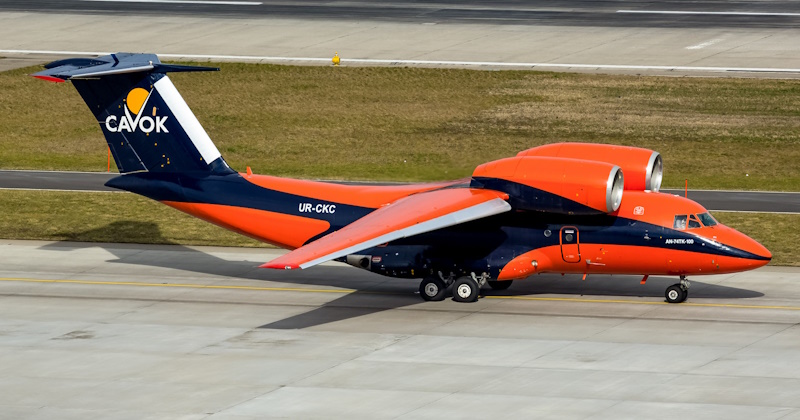
Typical VVS colors for the An-72 were overall gray. Typical Aeroflot colors for the An-74 were white top; gray bottom; and blue trim, most prominently fuselage and engine nacelle cheatlines. For Arctic operations, blue trim was replaced by red trim to make the aircraft easier to spot if it went down in the snows. It was by no means unusual for VVS machines to fly in Aeroflot colors, the dividing line between military and civil in the USSR being indistinct. Apparently it was common to paint a black strip on the wings behind the engine exhausts -- there being no point in trying to paint them any other colors, just to be covered by exhaust soot.
BACK_TO_TOP* In service, the An-72 / An-74 was generally appreciated by aircrews for its benign handling and superb STOL performance. It was also generally reliable, at least once the bugs were worked out -- though it was more complicated and so harder to maintain than predecessors like the An-26, service crews finding the high-mounted engines a particular pain. From the front, the engines gave the impression of oversized "ears", and so the machine was nicknamed "Cheburashka", after a well-known cartoon character, a furry creature with oversized ears.
Since the An-72 / An-74 was introduced in the last years of the Soviet Union, it never became widespread in service, being used for special roles like VIP transport. It left something to be desired as a paradrop platform, being too small to parachute vehicles and large cargoes, and it seems the downwash from the high-mounted engines was also an issue. With the collapse of the USSR in the early 1990s, production focus shifted from the military An-72 to the civil An-74, with foreign sales as a major objective.
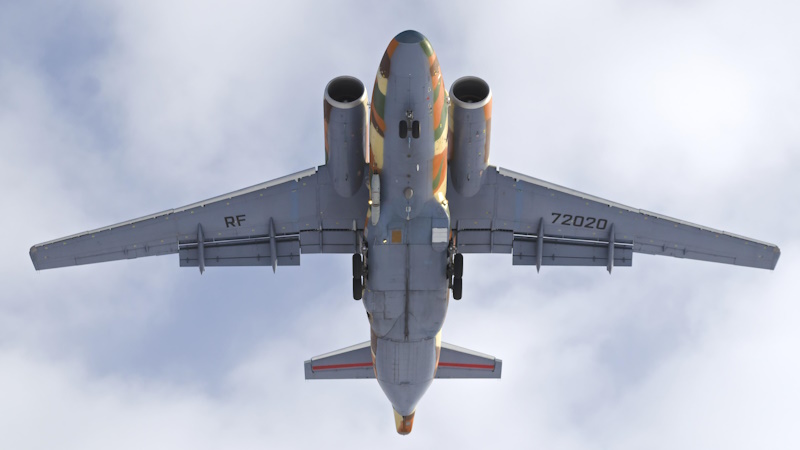
* An-72 subvariants included:
Proposed An-72 variants that never flew included a search and rescue (SAR) platform for the Red Navy; an antisubmarine warfare (ASW) platform; a firefighting platform; a "carrier onboard delivery" aircraft to deliver cargoes to Red Navy aircraft carriers; one with air-cushion landing gear; and even a flying boat derivative.
One of the most unusual derivatives of the An-72 was the "An-71", which was an airborne early warning (AEW) machine. It featured a disk radome mounted on top of a forward-swept tailfin. Only two were built, with the first performing its initial flight on 12 July 1985, but it never entered production. NATO gave it the appropriate reporting name of "Madcap".
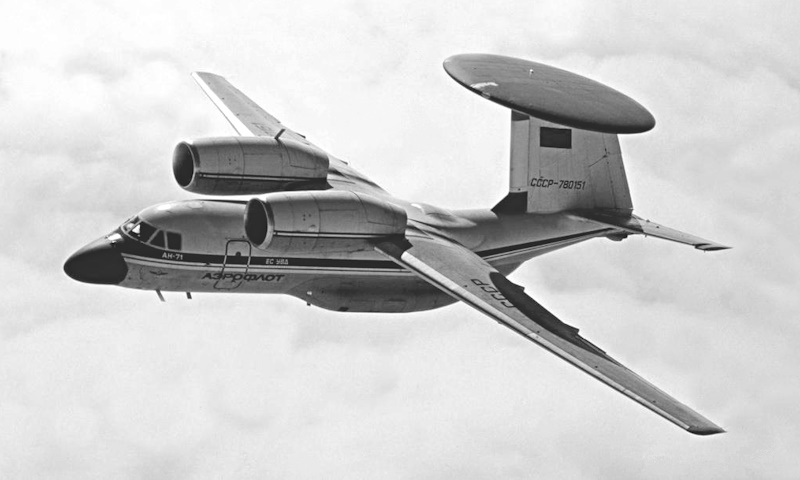
* Following production of the baseline An-74, there emerged a tangle of subvariants, derived from the "An-74MP", an An-74 modified as a demonstrator carrying avionics gear allowing it to perform international commercial operations. An-74 subvariants included:
* It is unclear just how many An-72 and An-74 machines were built -- estimates vary from about 160 to 250. All production machines were built by the Kharkiv factory, except for a half-dozen assembled in a factory in Omsk from Kharkiv-supplied kits, as part of an exercise to set up a duplicate production line that went nowhere in particular.

Production ceased with the breakdown of relations between Ukraine and Russia. Of those produced, most are still in service. Of course, Russia remains the biggest operator by far, with dozens flying with the VVS, and good numbers in operation with various civil operators; as mentioned above, the Border Guards operate the An-72P patrol variant, and also have some transport and VIP machines. Ukraine has a few dozen machines, including a small fleet of prototype and trials aircraft retained at the Antonov organization facility in Kyiv. The An-72 / An-74 has been seen in small numbers in other former Soviet states and Bulgaria as well.
Elsewhere, the Iranians obtained a dozen new-build machines in the late 1990s for use by the Revolutionary Guards, painted in disruptive camouflage colors, while Angola acquired a half-dozen used machines for military service. Purchased or leased An-72 / An-74 aircraft could also at times be found in service in about a dozen African states, Indonesia, Laos, Colombia, Peru, and even the UK. Some of the aircraft flown in civil service have featured flashy and elaborate color schemes; since the 1990s, the type has been used to support the Paris-Dakar road rally, with aircraft painted in colors compatible with the cars and their teams.
BACK_TO_TOP* In the 1990s, the Antonov organization worked on a substantially revised member of the An-72 / An-74 family, which emerged as the "An-74TK-300". It was effectively an An-74TK-200 -- in fact, the An-74TK-300 prototype was built from an airframe in construction as an An-74TK-200 -- featuring ZMKB Progress D-436T1 turbofans in an underwing nacelle configuration, the need for extreme STOL performance not being seen as necessary for its intended markets. The new engines provided 73.6 kN (7,500 kgp / 16,530 lbf) thrust and were 20% more fuel-efficient than the D-36 Series 3A engines they replaced; they were also fitted with cowling-type thrust reversers. The An-74TK-300 featured many more windows for passengers.
Initial flight of the prototype was in 2001. The Antonov organization promoted a wide range of variants, but though orders were reported, the only aircraft known to have been built in the series was the prototype, which ended up as a Ukrainian state VIP transport.
* It seems that customers were really more interested in a new-design aircraft, and so Antonov engineers began work on the "An-148", which performed its first flight in December 2004. While the An-148 had an overall configuration along the lines of the An-74TK-300 -- high-wing jetliner with twin D-436 turbofans in underwing nacelles, tee tail, and all-swept flight surfaces -- the An-148 had clearly different lines, and it is hard to know how much commonality the An-148 had with the An-74TK-300. One revealing detail was that the An-148's main gear has dual side-by-side wheels, instead of tandem wheels, suggesting that the new aircraft had been largely rethought.
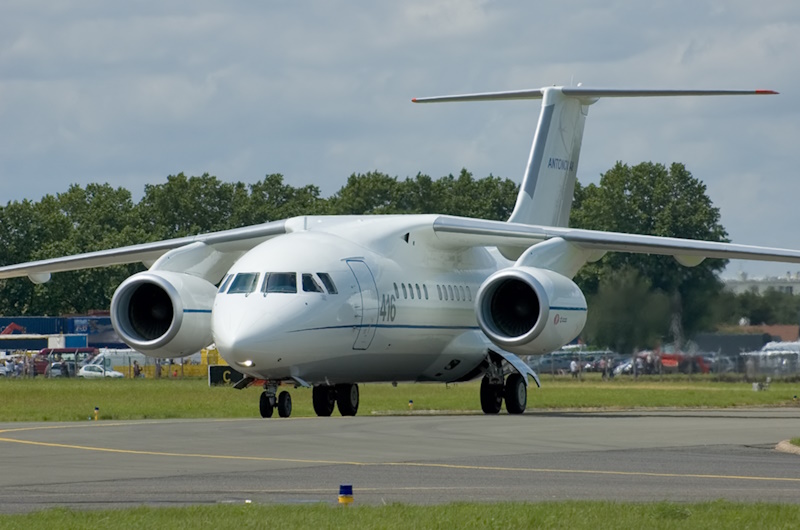
The "An-148-100" baseline jetliner configuration could seat 75 passengers. Higher-weight derivatives area on offer. Cargolifters with a side cargo door or tail ramp are also available, as are "combi" versions and "special mission" configurations. An "An-158" derivative performed its first flight in 2010, with this variant featuring a 1.7-meter (5 foot 2 inch) longer fuselage, raising passenger capacity to 99 seats in a single-class configuration; it also sported winglets.
Only about 40 An-148 / An-158 machines were delivered. The first of two prototypes for a militarized derivative of the An-158, the "An-178", featuring a rear loading ramp, was flown in 2015, being displayed in Dubai late in that year. Work was also conducted on a maritime patrol derivative, the "An-148-300MP"; however, the An-148 has since disappeared. Whether or not it re-appears in the future remains to be seen.
BACK_TO_TOP* Sources include:
Such details as were available on the An-148/158 were mostly obtained from the online Wikipedia and its reference links.

* Illustrations credits:
* Revision history:
v1.0.0 / 01 sep 10 v1.0.1 / 01 aug 12 / Review & polish. v1.0.2 / 01 jul 14 / Review & polish. v1.1.0 / 01 jun 16 / Review & polish. v1.1.1 / 01 may 18 / Review, update, & polish. v1.1.2 / 01 apr 20 / Review & polish. v1.1.3 / 01 jul 22 / Review & polish. v1.1.4 / 01 jun 24 / Review & polish. v1.2.0 / 01 nov 24 / Illustrations update. (*)BACK_TO_TOP
